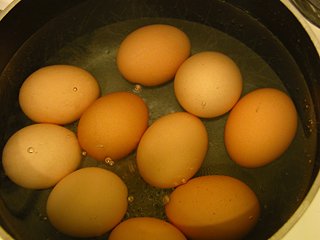How to boil eggs
Oh, you think I'm joking? Nope, you can screw up even just boiling an egg. I know: I've done it. So, here is what I learned from my mistakes.
What you need
— A pot of appropriate size for the number of eggs
— Eggs
— Salt
— White vinegar
— Cold tap water
Directions
- If you can, take the eggs out of the fridge at least half an hour before you need them.
- Arrange the eggs in the pot so they don't move around (that's why you need a pot of appropriate size).
- Fill with cold tap water until the eggs are covered by at least an inch of water.
- Add salt and a dash of white vinegar to the water. In case the eggs crack, the acidity of the vinegar will cause the albumen to coagulate near the crack and prevent it from spilling into the water. It doesn't have to be white vinegar, but that way it won't stain the eggs.
- Bring slowly to the boil. If you set the heat at max level, the eggs may crack, especially if they are coming straight from the fridge.
- When the water reaches boiling point, adjust the heat so the water is boiling gently. You are simmering the eggs, more than boiling them.
- Let the eggs cook this way for ten minutes.
- Set the eggs aside to cool down before using, especially if you need to peel them. To speed up the cooling process, you can put them in a bowl with cold water.
- Once the eggs are reasonably cooled off, you can peel them.
Related tip
When you transfer the eggs from the carton to the fridge compartment, you lose the expiration (or packing) date. Tear off the date from the carton and put it with the eggs (see picture above), and you'll always know how old they are.
Note
Now that you can boil eggs, you can make "uova alla diavola" (deviled eggs). We'll do that next.
See How to peel eggs.

